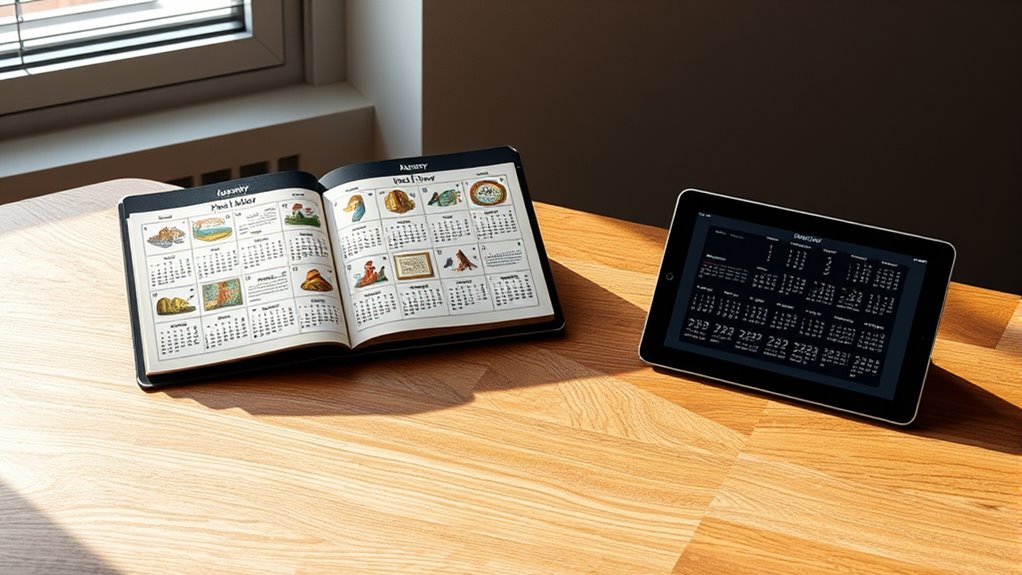The One-Calendar Principle encourages you to centralize all your commitments into a single calendar, making your schedule clearer and easier to manage. It helps you avoid double-booking, reduces mental clutter, and boosts efficiency by giving you a real-time view of what’s ahead. With everything in one place, you can plan proactively, prioritize tasks better, and balance your personal and professional life. Keep exploring to discover how this simple shift can transform your time management.
Key Takeaways
- The One-Calendar Principle emphasizes consolidating all commitments into a single system for clarity and efficiency.
- It reduces scheduling conflicts by providing a unified view of daily, weekly, and monthly obligations.
- This approach streamlines planning, prioritization, and time management across personal and professional activities.
- It enhances reliability by minimizing missed deadlines and forgotten events through comprehensive visibility.
- Adopting a single calendar promotes better communication, flexibility, and overall scheduling effectiveness.

Have you ever wondered if managing multiple calendars is the most efficient way to stay organized? Juggling separate schedules for work, personal life, and other commitments can quickly become overwhelming, leading to missed appointments and wasted time. Embracing the One-Calendar Principle can transform how you approach organization, improving your overall time management and scheduling efficiency. Instead of maintaining a fragmented system, you consolidate all your commitments into a single, unified calendar. This way, you get a clear, real-time overview of your day, week, and month, making it easier to prioritize tasks and allocate your time wisely.
When you rely on one calendar, you eliminate the risk of double-booking or forgetting important events. Everything is visible in one place, so you can see how your commitments overlap or leave gaps for focused work or relaxation. This holistic view enhances your scheduling efficiency because you no longer need to cross-reference multiple sources or remember scattered details. As soon as you add an appointment, meeting, or personal activity, it’s instantly integrated into your overall schedule, reducing cognitive load and mental clutter. This streamlining makes it easier to plan ahead, allocate blocks of time for specific tasks, and avoid last-minute surprises.
Using a single calendar also encourages better time management because it forces you to see the true scope of your day. You become more aware of how much free time you actually have and where you might be wasting it. For example, you might realize that you’re overcommitting on certain days or consistently leaving no time for breaks. With this awareness, you can make intentional adjustments to create a more balanced and manageable schedule. Additionally, a unified calendar promotes consistency. When everything is centralized, you’re less likely to overlook deadlines or forget important events, which reduces stress and increases your confidence in meeting your commitments. Incorporating a comprehensive approach to your planning helps to ensure all aspects of your life are balanced and well-managed.
A single calendar reveals your true schedule, helping you balance commitments and reduce stress through better time awareness.
Transitioning to one calendar doesn’t mean sacrificing flexibility; it means gaining better control over your time. You can set priorities more effectively, ensuring that high-value activities get the attention they deserve. It also simplifies communication with others—sharing your availability becomes straightforward, reducing back-and-forth emails or miscommunications. Ultimately, adopting the One-Calendar Principle is about working smarter, not harder. It’s a simple shift that can lead to significant improvements in your time management and scheduling efficiency, giving you more clarity, fewer errors, and a greater sense of control over your busy life.
Frequently Asked Questions
How Does the One-Calendar System Impact International Scheduling?
You’re likely to find that the one-calendar system improves international scheduling by promoting cultural synchronization and easing global coordination. When everyone uses the same calendar, it reduces confusion, streamlines meetings, and helps different regions plan events more effectively. This unified approach minimizes misunderstandings, boosts efficiency, and fosters smoother communication across borders, making it easier for you to coordinate activities and maintain strong international relationships in a more synchronized and organized way.
What Are Common Challenges in Implementing the One-Calendar Principle?
Ever wondered what makes implementing the one-calendar principle tricky? You face cultural resistance from those loyal to traditional systems, which can slow adoption. Logistical complexity also poses a challenge as coordinating across different regions requires significant planning and resources. You might find it hard to get everyone on board, and overcoming ingrained habits takes patience. Are you prepared to navigate these hurdles to create a unified scheduling system?
Are There Notable Organizations Successfully Using This Calendar Approach?
Yes, some organizations successfully implement this calendar approach, especially those focused on standardization efforts across departments. You’ll find that cultural adoption plays a key role, as teams embrace unified scheduling to improve coordination. These organizations often lead by example, promoting consistent practices that help everyone stay aligned. With strong leadership and clear communication, you can overcome resistance and foster widespread acceptance of the one-calendar system, ensuring smoother operations.
How Does the One-Calendar Principle Address Leap Years?
The One-Calendar Principle handles leap year adjustments by adding an extra day every four years, ensuring calendar consistency over time. This method keeps your schedule aligned with the solar year, preventing drift. When you follow this approach, you avoid long-term discrepancies, maintaining accuracy in date tracking. By making these adjustments, the calendar remains reliable, allowing you to plan events and activities without confusion caused by seasonal shifts.
What Technological Tools Support the One-Calendar System?
You can support the one-calendar system with digital tools like calendar apps that offer digital synchronization and cloud integration. These tools automatically update events across multiple devices, guaranteeing consistency and accuracy. By leveraging cloud-based platforms, you guarantee your calendar stays synchronized in real-time, making it easy to manage schedules centrally. This seamless integration helps maintain the integrity of the one-calendar principle, reducing errors and enhancing coordination across personal and professional contexts.
Conclusion
As you look at your calendar, it’s like a perfectly synchronized dance, where each event falls seamlessly into place. The one-calendar principle isn’t just about organization; it’s about creating harmony out of chaos. When your appointments align, it’s as if the universe conspired to keep everything flowing smoothly. You realize that, like a well-tuned clock, your schedule becomes a reflection of balance, reminding you that clarity often comes from simple, intentional design.









